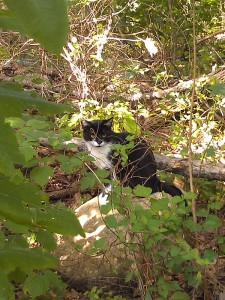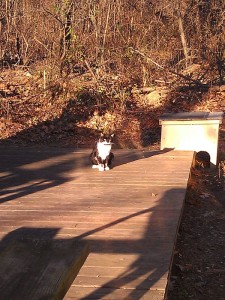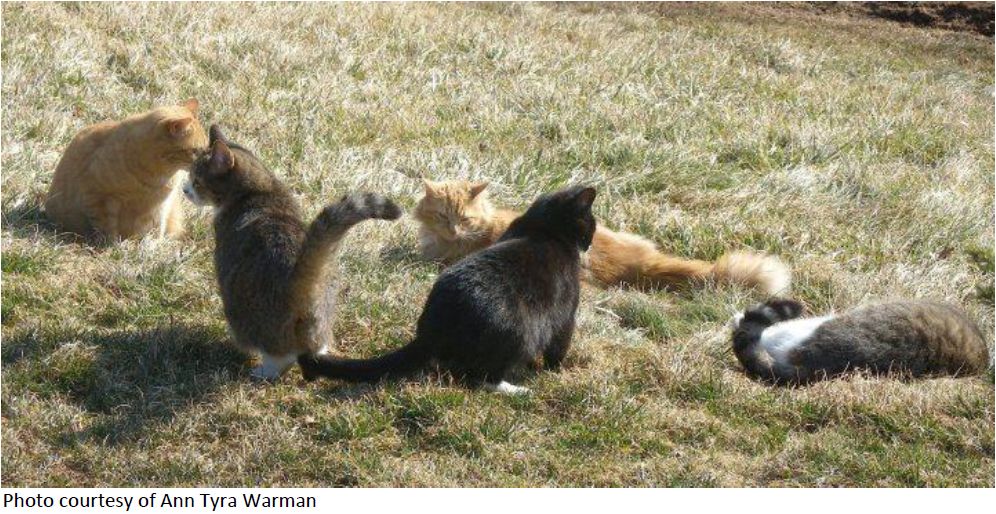 Written by Laurie Goldstein, January 2013
Written by Laurie Goldstein, January 2013
You’ve seen them everywhere: patrolling our cities’ alleys, the neighborhood garbage cans, our backyards, our campgrounds, our farms. They are our pets that darted out the door, escaped out a car window, broke through the screen, were let outside to “do their business” while in heat, or thrown away when they weren’t cute or convenient anymore. “They” are primarily the offspring of our unaltered kitties that never found their way home.
 According to The Humane Society of the United States, six to eight million companion animals are admitted to shelters each year. Three to four million of these are lucky enough to be adopted into new homes. The other three to four million are killed each year (or “euthanized,” if you prefer) in order to make room for the seeming endless stream of homeless animals. And 70% of the pets killed in shelters are cats.
According to The Humane Society of the United States, six to eight million companion animals are admitted to shelters each year. Three to four million of these are lucky enough to be adopted into new homes. The other three to four million are killed each year (or “euthanized,” if you prefer) in order to make room for the seeming endless stream of homeless animals. And 70% of the pets killed in shelters are cats.
The estimates of the number of feral cats in the U.S. are wide-ranging. Credible estimates range from 13 million to 87 million. To put this in perspective, according to the current American Pet Products Association National Survey, 38.9 million households in the U.S. own 86.4 million pet cats. While cat lovers may feel even one homeless cat is too many, that there are millions of them should be unacceptable to all of us. The question is – what do we do about it?
Eradication does not work. The traditional method of controlling unwanted seemingly feral animals is simply to trap them, remove them, and kill them after a short holding period (typically three to five days) to ensure no one comes looking for that kitty. This has been practiced across the country for decades: yet populations of feral cats remain. An example of just how ineffective eradication efforts are is Marion Island, a small “inhospitable” island (12 miles x 8 miles) off the coast of South Africa. In 1949, a group of scientists left behind five unsterilized cats when done with their work. By 1975 there were an estimated 2,500 cats on the island, home to an endangered ground nesting seabird. A feral cat eradication program was enacted. The cats were poisoned, hunted, and poisoned again in several programs. Finally, in 1991, no cats were seen on the island. It took 16 years to eradicate approximately 3,000 cats with “rapid” methods of eradication that cannot be used in populated areas. No wonder former President of the National Animal Control Association (NACA), Mark Kumpf, likened trap and kill programs to “bailing the ocean with a thimble.”
Trap-Neuter-Return (TNR). TNR is a proven method of humanely, effectively, and affordably controlling community cat populations. The concept is simple. Humanely trap the cats, have them spayed or neutered, vaccinated for rabies, then return them for release to the colony/area where they were trapped, allowing the kitties to peacefully live out their lives. In the U.S., when sterilized, one of the ears is “tipped,” enabling caretakers and community members to easily identify previously sterilized cats once released. Colony caretakers provide food, water, and shelter. Kittens, stray cats, and friendly cats are removed for fostering and adoption.
As the cats can no longer reproduce, the colony population is immediately stabilized and diminishes over time. With kittens and friendly cats removed for fostering and adoption, TNR results in an immediate reduction in the community cat population. Additionally, by eliminating mating, the nuisance behavior of unsterilized animals that includes fighting, yowling and wandering (looking for mates) stops. Without hormones, the foul odor of unaltered males spraying to mark their territory is gone. TNR not only controls the unchecked growth of the community cats, it improves the health, behavior, and quality of life of the managed animals – who continue to provide us with rodent control.
Another valuable advantage to TNR is that when practiced by an entire community, it reduces the flow of cats and kittens into local shelters, reducing euthanasia rates and increasing adoption rates of cats already in the shelters. According to the Feral Cat Coalition based in San Diego, after implementing a TNR program citywide, the number of cats impounded and killed was 50% lower after five years. The reduction in the trap and kill rate was achieved with an adoption rate at shelters that remained constant and despite area (human) population growth. Prior to the implementation of TNR, the rate of cats impounded and killed was rising at a 15% annual rate.

TNR: An Enlightened Approach to Community Cat Management. How many communities would provide enough volunteers (or any volunteers at all?) to trap colony cats and kittens, knowing they are destined for euthanasia? When communities step up to provide low-cost spay/neuter services, volunteers provide the rest. TNR is in sync with the desire of the majority of citizens who want to see these cats left to live out their lives while minimizing their impact. Recognizing this, in 2008 the National Animal Control Association updated its “Feral Cat” policy statement, which formerly declared that animal control officers “should be empowered to remove all feral and unwanted cats from the community.” The new policy, labeled “Community Cat Management,” calls for animal control officers to be “empowered to manage all feral, stray and owned cats within the community,” where management may include education, public/private partnerships for cat care and control, spay/neuter programs, and regulated cat caretaker programs.
Not only is the traditional practice of trap and kill ineffective, as Mr. Kumpf put it in an interview with Animal Sheltering magazine, “There’s no [animal control] department that I’m aware of that has enough money in their budget to simply practice the old capture-and-euthanize policy; nature just keeps having more kittens.” TNR is not just the best alternative to managing community cat populations, it is the only one that works.
If you enjoyed this article or found it informative, please “Like” it, “Tweet” it, or share it using any of the buttons below. And don’t forget to check out our FB page, join the discussions in our awesome FB group and follow us on Twitter!
Created 02/23/13; Updated 08/11/14



